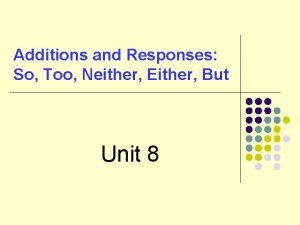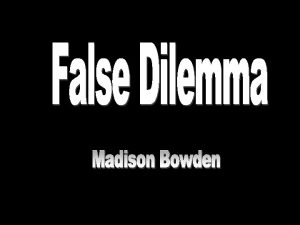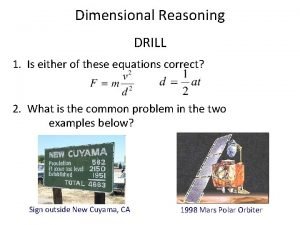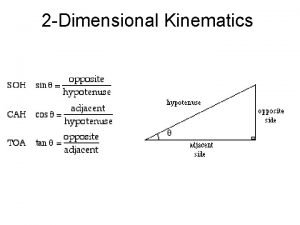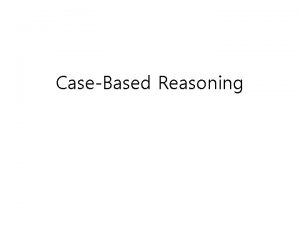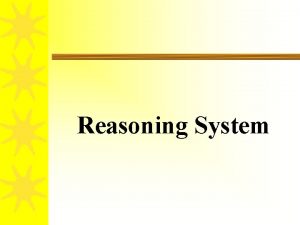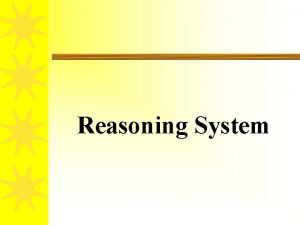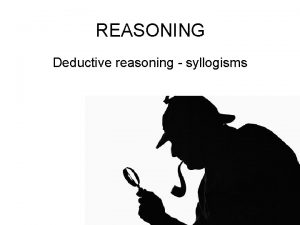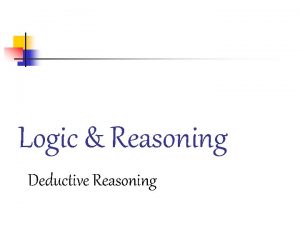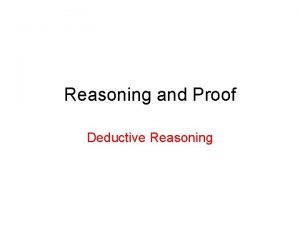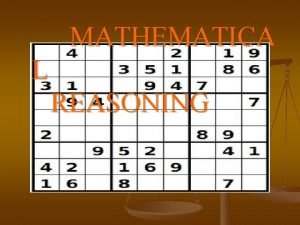Dimensional Reasoning DRILL 1 Is either of these






























- Slides: 30

Dimensional Reasoning DRILL 1. Is either of these equations correct? 2. What is the common problem in the two examples below? Sign outside New Cuyama, CA 1998 Mars Polar Orbiter

1. Is either of these equations correct? F: kg*m / s 2 m: kg d: m v: m / s a: m / s 2 kg*m / s 2 = kg*m 2 / s 2 m 2 = kg*m 2 s 2 m 2 kg*m / s 2 = kg / s 2

2. What is the common problem in the two images below? Pounds-force Newtons-force UNITS! $125 mil error: “Instead of passing about 150 km above the Martian atmosphere before entering orbit, the spacecraft actually passed about 60 km above the surface…This was far too close and the spacecraft burnt up due to friction with the atmosphere. ” – BBC News

Dimensional Reasoning Lecture Outline: 1. Units – base and derived 2. Units – quantitative considerations 3. Dimensions and Dimensional Analysis – fundamental rules and uses

Dimensional Reasoning Measurements consist of 2 properties: 1. a quality or dimension 2. a quantity expressed in terms of “units” Let’s look at #2 first: THE INTERNATIONAL SI SYSTEM OF MEASUREMENT IS COMPRISED OF 7 FUNDAMENTAL (OR BASE) QUANTITIES. THE ENGLISH SYSTEM, USED IN THE UNITED STATES, HAS SIMILARITIES AND THERE ARE CONVERSION FACTORS WHEN NECESSARY.

Dimensional Reasoning 2. a quantity expressed in terms of “units”: THE INTERNATIONAL SI SYSTEM OF MEASUREMENT IS COMPRISED OF 7 FUNDAMENTAL (OR BASE) QUANTITIES. BASE UNIT – A unit in a system of measurement that is defined, independent of other units, by means of a physical standard. Also known as fundamental unit. DERIVED UNIT - A unit that is defined by simple combination of base units. Units provide the scale to quantify measurements

SUMMARY OF THE 7 FUNDAMENTAL SI UNITS: 1. LENGTH - meter 2. MASS - kilogram 3. TIME - second 4. ELECTRIC CURRENT - ampere 5. THERMODYNAMIC TEMPERATURE - Kelvin 6. AMOUNT OF MATTER - mole 7. LUMINOUS INTENSITY - candela Quality (Dimension) Quantity – Unit

Units provide the scale to quantify measurements LENGTH YARDSTICK METER STICK

Units provide the scale to quantify measurements MASS

Units provide the scale to quantify measurements TIME ATOMIC CLOCK

Units provide the scale to quantify measurements ELECTRIC CURRENT

Units provide the scale to quantify measurements THERMODYNAMIC TEMPERATURE

Units provide the scale to quantify measurements AMOUNT OF SUBSTANCE

Units provide the scale to quantify measurements LUMINOUS INTENSITY

Units 1. A scale is a measure that we use to characterize some object/property of interest. Let’s characterize this plot of farmland: The Egyptians would have used the length of their forearm (cubit) to measure the plot, and would say the plot of farmland is “x cubits wide by y cubits long. ” The cubit is the scale for the property length y x

Units 7 historical units of measurement as defined by Vitruvius Written ~25 B. C. E. Graphically depicted by Da Vinci’s Vitruvian Man

Units 2. Each measurement must carry some unit of measurement (unless it is a dimensionless quantity). Numbers without units are meaningless. I am “ 72 tall” 72 what? Fingers, handbreadths, inches, centimeters? ?

Units 3. Units can be algebraically manipulated; also, conversion between units is accommodated. Factor-Label Method Convert 16 miles per hour to kilometers per second:

Units 4. Arithmetic manipulations between terms can take place only with identical units. 3 in + 2 in = 5 in 3 m + 2 m = 5 m 3 m + 2 in = ? (use factor-label method)

“ 2 nd great unification of physics” for electromagnetism work (1 st was Newton) Dimensions are intrinsic to the variables themselves

Base Derived Characteristic Length Mass Time Area Volume Velocity Acceleration Force Energy/Work Power Pressure Viscosity Dimension L M T L 2 L 3 LT-1 LT-2 ML 2 T-2 ML 2 T-3 ML-1 T-2 ML-1 T-1 SI (MKS) m kg s m 2 L m/s 2 N J W Pa Pa*s English foot slug s ft 2 gal ft/s 2 lb ft-lb/s or hp psi lb*slug/ft

Dimensional Analysis Fundamental Rules: 1. Dimensions can be algebraically manipulated.

Dimensional Analysis Fundamental Rules: 2. All terms in an equation must reduce to identical primitive (base) dimensions. Homogeneous Equation Dimensional Homogeneity

Dimensional Analysis Opening Exercise #2: Non-homogeneous Equation Dimensional Non -homogeneity

Dimensional Analysis Uses: 1. Check consistency of equations:

Dimensional Analysis Uses: 2. Deduce expressions for physical phenomena. Example: What is the period of oscillation for a pendulum? (time to complete full cycle) We predict that the period T will be a function of m, L, and g:

Dimensional Analysis 1. 2. 3. 4. 5. 6. power-law expression

Dimensional Analysis 6. 7. 8. 9.

Dimensional Analysis Uses: 2. Deduce expressions for physical phenomena. What we’ve done is deduced an expression for period T. 1) What does it mean that there is no m in the final function? The period of oscillation is not dependent upon mass m – does this make sense? 2) How can we find the constant C? Further analysis of problem or experimentally

Uses: Dimensional Analysis 2. Deduce expressions for physical phenomena. Chalkboard Example: A mercury manometer is used to measure the pressure in a vessel as shown in the figure below. Write an expression that solves for the difference in pressure between the fluid and the atmosphere.
 A circular motion is one dimensional
A circular motion is one dimensional Every quiz has been easy. therefore, the quiz will be easy
Every quiz has been easy. therefore, the quiz will be easy Example of a deductive argument
Example of a deductive argument Inductive reasoning patterns
Inductive reasoning patterns Difference between inductive and deductive reasoning
Difference between inductive and deductive reasoning What is argument in logic
What is argument in logic Differences between deductive and inductive reasoning
Differences between deductive and inductive reasoning Deductive reasoning moves you from:
Deductive reasoning moves you from: Germany either be a world power or will not be at all
Germany either be a world power or will not be at all George and tamara doesn't or don't
George and tamara doesn't or don't So too either neither
So too either neither How many kids liked either pears or bananas
How many kids liked either pears or bananas An ecosystem in which water either covers the soil
An ecosystem in which water either covers the soil Responses with so and neither
Responses with so and neither There is either obedience or the church
There is either obedience or the church Informal vs formal social control
Informal vs formal social control A feeling of visual equality in shape form value color
A feeling of visual equality in shape form value color Either or fallacy
Either or fallacy Word formation engleski
Word formation engleski Haskell data.map
Haskell data.map Eponichium
Eponichium Example of subject-verb agreement
Example of subject-verb agreement Neither a nor b
Neither a nor b Map maybe haskell
Map maybe haskell A sentence that is either true or false
A sentence that is either true or false Time reference words
Time reference words Either
Either Singular and plural subject
Singular and plural subject Independent v dependent variable
Independent v dependent variable Which sentence presents a faulty either/or argument?
Which sentence presents a faulty either/or argument? Anecdotal fallacy
Anecdotal fallacy













